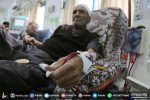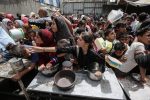The Ain Al-Hilweh Palestinian refugee camp in Lebanon is known as the “capital of Palestinian shatat”. The term might not stir many emotions among those who do not fully understand let alone experience the harrowing existence of ethnic cleansing and perpetual exile and the tremendous violence which followed.
‘Shatat’ is translated roughly as “exile” or “diaspora”. However the meaning is much more complex. It can only be understood through lived experience. Even then it is still not easy to communicate. Perhaps the Kafkaesque blocks of concrete zinc and rubble towered one on top of another and serving as “temporary shelters” for tens of thousands of people tell a small part of the story.
Violence in the extremely crowded Palestinian camp resumed on 30 July it was interrupted briefly after the intervention of the Palestinian Joint Action Authority then resumed harvesting the lives of 13 people and counting. Scores more were injured and thousands have fled.
Yet the majority of the refugees stayed because several generations of Palestinians in Ain Al-Hilweh understand that there is a point where running away serves no purpose for it neither guarantees life nor even a dignified death. The massacres in the Sabra and Shatila refugee camps in September 1982 stand as a testament to this collective realization.
Before writing this I spoke to several people in South Lebanon and sorted through many articles and reports describing what is taking place in the camp now. The truth is still blurry or at best selective.
Many in the Arabic media have largely relegated Ain Al-Hilweh to a symbolic representation of a rooted Palestinian pain. Mainstream Western media was hardly concerned about Palestinian pain but focused mostly on the ‘lawlessness’ of the camp the fact that it exists outside the legal jurisdiction of the Lebanese army and the proliferation of weapons among Palestinian and other factions therein which are engaged in seemingly endless and supposedly inexplicable infighting.
But Ain Al-Hilweh like the eleven other formal Palestinian refugee encampments in Lebanon is a story of something else entirely more urgent than mere symbolism and more rational than being the outcome of lawless refugees. It is essentially the story of Palestine or rather the destruction of Palestine at the hands of Zionist militias in 1947-48. It is a story of contradictions pride shame hope despair and ultimately betrayal.
It is not easy to follow the timeline prior to the latest round of violence. Some suggest that the fighting began when an assassination attempt &mdash blamed on Fatah fighters in the camp &mdash was carried out against a leader of a rival Islamist group. The attempt failed and was followed by an ambush by alleged Islamists who killed a top Fatah commander and several of his bodyguards.
Others suggest that the assassination of the General of the Palestinian National Security Abu Ashraf Al-Armoushi was completely unprovoked. Yet others including Lebanese Prime Minister Najib Mikati blamed outside forces and their “repeated attempts to use Lebanon as a battleground for the settling of scores.”
But who are these entities and what is the point of such meddling?
It gets murkier. Although impoverished and overcrowded Ain Al-Hilweh like other Palestinian camps is a greatly contested political space. In theory these camps are meant to solidify and protect the legitimate Right of Return for Palestinian refugees. In practice they are also used to undermine this internationally enshrined right.
The Palestinian Authority led by Mahmoud Abbas for example wants to ensure that Fatah loyalists dominate the camp hence its laboring to deny Palestinian rivals any role in South Lebanon.
Fatah is the largest Palestinian group within the Palestine Liberation Organisation (PLO). It dominates both the PLO and the Palestinian Authority. In the past the group lost its dominance over Ain Al-Hilweh and other camps. For Fatah in Lebanon it is a constant struggle for relevance.
Ain Al-Hilweh is important for the PA even though the PLO under Abbas’s leadership has largely disowned the refugees of South Lebanon and their Right of Return it has focused mostly on governing specific regions in the West Bank under the auspices of the Israeli occupation.
Yet Lebanon’s refugees remain important for the PA for two main reasons: one as a source of validation for Fatah and two to stave off any criticism of let alone resistance to the Western-backed Palestinian camp in Lebanon and everywhere else.
Throughout the years hundreds of Ain Al-Hilweh refugees have been killed in Israeli bombings as well as Palestinian-Lebanese and Palestinian-Palestinian infighting. Israel did much of the killing to ensure Palestinian resistance in Lebanon is eliminated at the source. The rest of the violence was carried out by groups that sought dominance and power sometimes for their own sake but often as proxy militias for outside powers.
Trapped in the middle are 120000 people &mdash the estimated population of Ain Al-Hilweh &ndash and by extension all of Lebanon’s Palestinian refugees.
Not all of Ain Al-Hilweh’s inhabitants are registered Palestinian refugees though. The latter are estimated by the UN agency created to look after Palestine refugees UNRWA at approximately 63000. The rest fled there following the start of the Syrian war which swelled the population of the Lebanon camps and heightened existing tensions.
The entrapments of refugees however are manifold: the actual physical confinement dictated by the lack of opportunities and acceptance in mainstream Lebanese society the great risks of leaving Lebanon as undocumented refugees smuggled across the Mediterranean and the feeling especially among the older generations that leaving the camps is tantamount to the betrayal of the Right of Return.
All of this is happening in a political context where the Palestinian leadership has completely removed the refugees from its calculations and where the PA only sees the refugees as pawns in a power play between Fatah and its rivals.
For decades Israel has sought to dismiss the discussion on Palestinian refugees and their Right of Return. Its constant attacks on Palestinian refugee camps in Palestine itself and its interest in what is taking place in the shatat is part of its quest to shake the very foundation of the Palestinian cause.
Infighting in Ain Al-Hilweh if not brought under total and lasting control might eventually get Israel exactly what it wants: presenting Palestinian refugees as a liability to host countries and ultimately destroying the “capital of shatat” along with the hope of four generations of Palestinian refugees to one day go back home.
– Ramzy Baroud is a journalist and the Editor of the Palestine Chronicle. He is the author of five books. His latest is ‘These Chains Will Be Broken: Palestinian Stories of Struggle and Defiance in Israeli Prisons’. Baroud is a Non-resident Senior Research Fellow at the Center for Islam and Global Affairs (CIGA) and also at the Afro-Middle East Center (AMEC).












